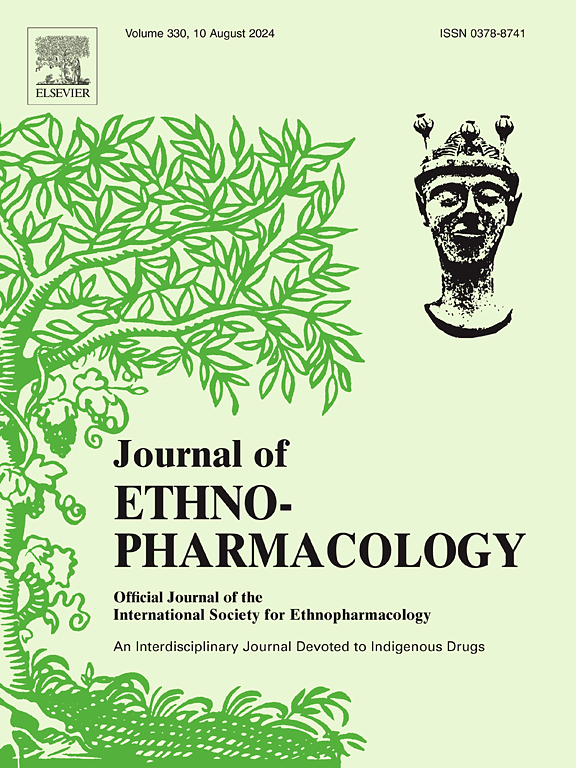Erzhi pill promotes norepinephrine synthesis in locus coeruleus through ERβ-TFAP2A-TH plays a neuroprotective role
IF 4.8
2区 医学
Q1 CHEMISTRY, MEDICINAL
引用次数: 0
Abstract
Ethnopharmacological relevance
Erzhi Pill (EZP), a classical Chinese herbal formula for yin-nourishing and kidney-tonifying, has been traditionally prescribed for insomnia and amnesia, and shows therapeutic potential for Alzheimer's disease (AD). However, its active components and precise mechanisms of action against AD remain elusive.
Aim of the study
This study aimed to identify the key active components and molecular targets of EZP responsible for improving cognitive dysfunction and to elucidate its underlying mechanisms.
Matreials and methods
Behavioral and histomorphological analyses will be used to validate the efficacy of EZP in ameliorating cognitive impairment in lipopolysaccharide (LPS)-induced models. Untargeted metabolomics characterized metabolic profile alterations in the locus coeruleus (LC), while targeted metabolomics focused on specific metabolic pathways. Microdialysis coupled with high-resolution mass spectrometry (HR-MS) analyzed EZP's chemical components in LC dialysates. Network pharmacology and molecular docking predicted potential targets, with binding affinities validated by surface plasmon resonance (SPR). Molecular biology techniques were employed to investigate relevant signaling pathways.
Results
EZP significantly improved learning and memory capabilities in LPS-induced models, accompanied by enhanced neuronal activity. Metabolomic profiling revealed that EZP exerted its effects primarily through modulation of alanine, aspartate, and glutamate metabolism pathways, as well as phenylalanine and tyrosine metabolic networks. Specifically, EZP treatment resulted in decreased tyrosine (Tyr) levels and increased norepinephrine (NE) concentrations in the LC. Western blot analysis further demonstrated upregulated expression of tyrosine hydroxylase (TH) and dopamine β-hydroxylase (DβH) proteins in LC tissues. Phytochemical analysis identified 45 prototype components and 14 metabolites in EZP, among which apigenin and wedelolactone were characterized as potential bioactive ingredients. Network pharmacology combined with molecular docking revealed estrogen receptor β (ERβ) as a critical target mediating EZP's anti-AD effects. SPR validated stronger binding affinity of apigenin and wedelolactone to ERβ compared with G-protein-coupled receptor 30 (GPR30). Mechanistic studies showed that these compounds activated ERβ signaling, restored TFAP2A/TH transcriptional activity, and promoted NE biosynthesis, thereby ameliorating cognitive deficits in AD models.
Conclusion
This study not only elucidates that EZP ameliorates cognitive dysfunction in AD)via the ERβ-TFAP2A/TH signaling pathway but also proposes NE augmentation as a novel therapeutic strategy for AD management.
二痔丸通过ERβ-TFAP2A-TH促进蓝斑区去甲肾上腺素的合成,具有神经保护作用。
民族药理学相关性:二栀丸(EZP)是一种具有滋阴补肾作用的经典中药配方,传统上用于治疗失眠症和健忘症,并显示出治疗阿尔茨海默病(AD)的潜力。然而,其有效成分和对抗AD的确切机制仍不清楚。研究目的:本研究旨在确定EZP改善认知功能障碍的关键活性成分和分子靶点,并阐明其潜在机制。材料和方法:行为学和组织形态学分析将用于验证EZP改善脂多糖(LPS)诱导的认知障碍模型的疗效。非靶向代谢组学表征蓝斑座(LC)的代谢谱改变,而靶向代谢组学关注特定的代谢途径。微透析联用高分辨率质谱(HR-MS)分析LC透析液中EZP的化学成分。网络药理学和分子对接预测潜在靶点,结合亲和力通过表面等离子体共振(SPR)验证。应用分子生物学技术研究相关信号通路。结果:EZP显著改善lps诱导模型的学习和记忆能力,并伴有神经元活性增强。代谢组学分析显示,EZP主要通过调节丙氨酸、天冬氨酸和谷氨酸代谢途径以及苯丙氨酸和酪氨酸代谢网络发挥作用。具体而言,EZP处理导致LC中酪氨酸(Tyr)水平降低和去甲肾上腺素(NE)浓度升高。Western blot分析进一步证实LC组织中酪氨酸羟化酶(TH)和多巴胺β-羟化酶(DβH)蛋白表达上调。植物化学分析鉴定出EZP的45种原型成分和14种代谢物,其中芹菜素和维德内酯被鉴定为潜在的生物活性成分。网络药理学结合分子对接发现雌激素受体β (estrogen receptor β, ERβ)是介导EZP抗ad作用的关键靶点。与g蛋白偶联受体30 (GPR30)相比,SPR验证了芹菜素和维德内酯与ERβ的结合亲和力更强。机制研究表明,这些化合物激活ERβ信号,恢复TFAP2A/TH转录活性,促进NE生物合成,从而改善AD模型的认知缺陷。结论:本研究不仅阐明了EZP通过ERβ-TFAP2A/TH信号通路改善AD认知功能障碍,而且提出了NE增强作为AD治疗的一种新的治疗策略。
本文章由计算机程序翻译,如有差异,请以英文原文为准。
求助全文
约1分钟内获得全文
求助全文
来源期刊

Journal of ethnopharmacology
医学-全科医学与补充医学
CiteScore
10.30
自引率
5.60%
发文量
967
审稿时长
77 days
期刊介绍:
The Journal of Ethnopharmacology is dedicated to the exchange of information and understandings about people''s use of plants, fungi, animals, microorganisms and minerals and their biological and pharmacological effects based on the principles established through international conventions. Early people confronted with illness and disease, discovered a wealth of useful therapeutic agents in the plant and animal kingdoms. The empirical knowledge of these medicinal substances and their toxic potential was passed on by oral tradition and sometimes recorded in herbals and other texts on materia medica. Many valuable drugs of today (e.g., atropine, ephedrine, tubocurarine, digoxin, reserpine) came into use through the study of indigenous remedies. Chemists continue to use plant-derived drugs (e.g., morphine, taxol, physostigmine, quinidine, emetine) as prototypes in their attempts to develop more effective and less toxic medicinals.
 求助内容:
求助内容: 应助结果提醒方式:
应助结果提醒方式:


